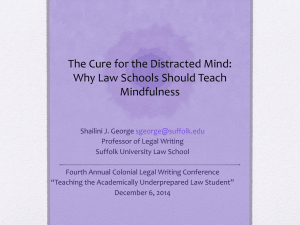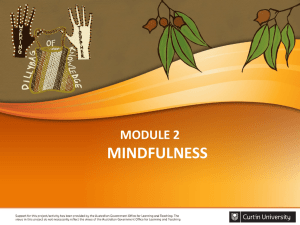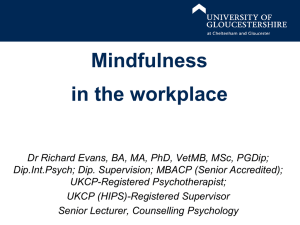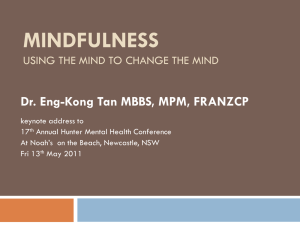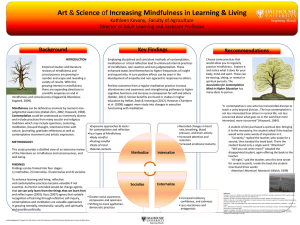Mindfulness and Psychotherapeutic Work
advertisement
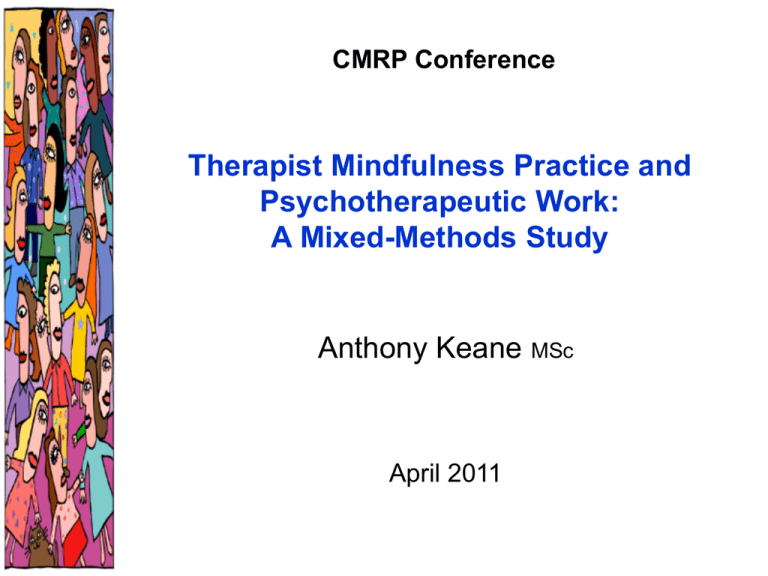
CMRP Conference Therapist Mindfulness Practice and Psychotherapeutic Work: A Mixed-Methods Study Anthony Keane MSc April 2011 Background Common Factors approach client–therapist relationship is strongest predictor of positive outcome (e.g. Lambert & Ogles, 2004) Therapist mindfulness practice may promote abilities and qualities associated with positive therapeutic relating (e.g. Crane & Elias, 2006; Hick & Bien, 2008; Siegel, 2007) Evidence for benefits of mindfulness practice for trainee psychotherapists and their clients (e.g. Grepmair et al., 2007; Schure et al., 2008) Present Study: Research Questions 1. What, if any, is the impact of personal mindfulness practice on the work of therapists? 2. Are levels of meditation experience associated with levels of mindfulness? 3. Are levels of mindfulness associated with the capacity for empathy? Method: Design Mixed-methods Phase 1: Postal survey (N = 40) Phase 2: Follow-up interviews (N =12) Method: Participants Inclusion Criteria Qualified (not trainees) Mindfulness practice at least once per week Demographics Gender: 25 females, 15 males Nationality: 32 Irish, 3 British, 1 Polish, 1 Dutch, 1 Indian, 1 American, 1 Australian Age: 30–60+ years Method: Phase 1 Instruments Mindfulness: Five Facet Mindfulness Questionnaire (FFMQ) (Baer et al., 2006) Observing Describing Acting With Awareness Nonjudging of Inner Experience Nonreactivity to Inner Experience Method: Phase 1 Instruments contd. Empathy: Interpersonal Reactivity Index (IRI) (Davis, 1983) Perspective Taking Empathic Concern Fantasy Personal Distress Mindfulness and Psychotherapeutic Work 8-item scale (designed for present study) Open-ended questions Method: Phase 2 Instruments Face-to-face follow-up interview (N = 12) Semi-structured schedule Results and Discussion: Selected Quantitative Findings Predominant Theoretical Orientations Theoretical Orientation n % Integrative 26 65 Humanistic–Existential 20 50 Psychodynamic 13 32 Body-Oriented 8 20 Cognitive-Behavioural 7 17 Systemic 5 12 Constructivist 3 7 Others 5 12 Meditation Practice Characteristic Range M SD Duration of practice in years 1 – 40 11.4 10.49 Frequency of sessions per week 2 – 20 6.8 3.68 Length of sessions in minutes 5 – 60 30 12.26 Meditation Practice Characteristic Range M SD Duration of practice in years 1 – 40 11.4 10.49 Frequency of sessions per week 2 – 20 6.8 3.68 Length of sessions in minutes 5 – 60 30 12.26 Most Frequent Mindfulness Practices 40 35 30 25 N 20 15 10 5 th . re a at in g E og a Y t em en M ov S pa ce ca n S B B od y ki ng W al S itt i ng 0 Meditation Experience and Mindfulness Meditation experience positively associated with: Nonjudging facet ( = .39, p = .012) Acting With Awareness facet ( = .34, p = .033) Mindfulness and Empathy IRI Perspective Taking IRI Fantasy IRI Empathic Concern IRI Personal Distress IRI Global Empathy .60** .11 .37* -.34* .52** .46** -.19 .11 -.53** .17 .44** -.12 .28 -.29 .28 .57** .16 .26 -.33* .48** .57** .04 .31 -.45** .44* FFMQ Observe FFMQ Describe FFMQ Awareness FFMQ Nonjudge FFMQ Nonreactivity *p .05. ** p .01. Mindfulness and Psychotherapeutic Work Quality of therapist attention (98%)* Awareness of own process with clients (95%) Awareness of dynamics like transference and counter-transference (78%) Ability to tolerate difficult emotional states (98%) Capacity for self-compassion (93%) Capacity for empathy (83%) Awareness of self-care needs (93%) Changed understanding of psychotherapy (68%) *Percentages refer to proportion of sample who agreed (agree or strongly agree) that mindfulness had a positive influence in the area specified Selected Qualitative Findings Main Themes Enhanced Attention and Awareness Benefits Challenges Therapist Qualities: Embodying Mindfulness Perspectives on Therapy Therapist Self-Care Mindfulness as Intervention Enhanced Attention and Awareness Mediate Benefits Heightens attention and awareness (27)* “Being present” (21) Greater voluntary control of attention (14) *Figures refer to number of times sub-theme was mentioned in qualitative responses in postal survey (N =40) “The added bit that mindfulness gives is that notion of taking the time to come in and take your seat, to feel, ‘Am I present? Am I in my body?’ A lot of my patients have physical traumas and are slightly dissociated from their bodies. I’ve learnt to be grounded to help them ground themselves as well.” (G) “Mindfulness meditation uses this fine beam of attention in a narrow focus and then broadens to a wider focus. When you are doing that deliberately with a client, your capacity to explore their internal geography improves. You really become a cartographer.” (J) much more sophisticated Enhanced Attention and Awareness Mediate Benefits Heightens attention and awareness (27)* “Being present” (21) Greater voluntary control of attention (14) “Listening deeply”: attunement (22) Awareness of interpersonal process and use of “self” (15) *Figures refer to number of times sub-theme was mentioned in qualitative responses in postal survey (N =40) “Mindfulness practice has deepened my levels of attention to both myself and my client, enabling me to have greater embodied awareness of the here and now. This facilitates meeting on a much deeper level – it can help cut through the dance of repeated patterns and dialogue. It helps me respond rather than react or collude with a client.” (K) “What I have found is that you’re picking up a lot of the patient’s transferences. You’re perhaps more aware of their body language, their tone of voice you can almost feel the fear, you can almost smell the depression and it’s really quite remarkable. Because you’re being empathic and listening, you also become aware of your own reactions.” (I) Challenges of Enhanced Attention and Awareness Personal challenges of heightened awareness (11/12 interviewees) self- “That’s been my experience: letting go your ideal self, letting go your conscious self. So, you really are coming down off those identifications into a much more uncertain place.” (G) “Within a short few months repressed trauma material arose a bit volcanically and that was very overwhelming for some time … one of the things that the practice asks of us is that we find a way to be with whatever is present no matter what it is.” (J) Challenges of Enhanced Attention and Awareness Personal challenges of heightened self- awareness (11/12 interviewees) Emergence of heightened sensitivity: a “double- edged sword” (5 interviewees) “I was very sensitive to everything. It was as if every emotion was magnified. Client stories were very upsetting – the positive sides were very joyful as well – it was a double-edged sword. That was definitely a challenge.” (F) “I notice that sometimes you go into a room with somebody and you can almost smell or take on board what it’s like to be them, and sometimes you just wish you weren’t feeling it too much. It’s a very intense way of working – particularly people who work like I do, psychodynamically or interpersonally. It’s very useful but also quite taxing.” (I) Challenges of Enhanced Attention and Awareness Heightened sensitivity: “modulates” over time Value of: support with practice; mindfulnessinformed supervision Main Themes Enhanced Attention and Awareness Benefits Challenges Therapist Qualities: Embodying Mindfulness Perspectives on Therapy Therapist Self-Care Mindfulness as Intervention “Embodying Mindfulness”: Therapist Qualities Qualities and attitudes associated with practice e.g. compassion, non-judgment, equanimity (26)* “Embodied” through deepening practice Transfer to therapy work because: “mindfulness influences me as a person.” (P) *Figure refers to number of times theme was mentioned in qualitative responses in postal survey (N =40) “All these lovely notions of non-judgement and so on! One of the hard things that I had to go through was the level of judgements, selfjudgement. It’s much easier to understand Carl Rogers now. I’ve known it in a head sense for a long time, but now in a much deeper and more embodied way. That fundamental change is because I had to go through meeting that kind of stuff within myself in the practice, meeting a lack of compassion.” (K) “Embodying Mindfulness”: Nonjudging Quantitative data Meditation experience FFMQ Nonjudging FFMQ Nonjudging IRI Empathy (3 subscales) Qualitative data Ongoing integration of nonjudging at personal and interpersonal levels “Embodying Mindfulness”: Therapist Qualities Transfer to therapy work – implicit in presence of therapist Therapist as “holding container” – “active presence” (10)* *Figure refers to number of times sub-theme was mentioned in qualitative responses in postal survey (N =40) “In deepening my practice I find that I can bring an embodied sense of mindfulness into the subjective and inter-subjective space – enabling a deeper listening and holding container which in itself is therapeutic for the client – enabling a felt sense of safety, trust and compassion.” (N) “It’s terrifying. I sit down on my cushion; I don’t know what’s going to come up here! … I became very familiar with the fact that no matter what I was feeling it came and went, was very impermanent, very much a thing. So I became less dazzled by my own sordid psyche and, therefore, when I’m sitting with someone else’s sordid psyche which is haemorrhaging all over the place, I find it’s just the heart bleeding. It may need to bleed … I’m containing the space and keeping it safe.” (E) Conclusions Practical Implications Personal and professional benefits for therapists Enhances abilities (e.g. attention) and helps internalise qualities (e.g. empathy) that contribute to positive therapeutic relating A resource in occupational health of therapists Can present challenges – need for appropriate support and supervision Conclusions contd. Methodological Issues Selection bias and social desirability in responses? Value of flexible designs Future Directions Perspectives of clients and supervisors Prospective designs and comparative analysis Chart individual areas of influence over time Mind and Heart in the Present Moment “Mindfulness has enhanced my capacity to be present, to focus, to be still, to listen well, to be compassionate – to be in my heart while using my head”. (O)
